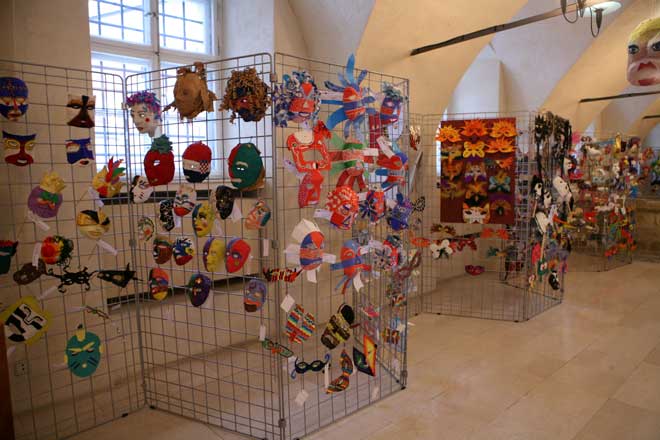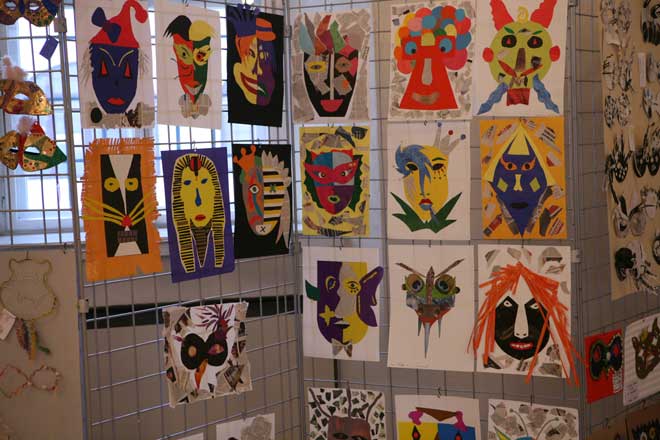12th Masks: Carnival Ball Masks
Zagreb City Museum in collaboration with Maksimir Culture and Information Centre
Project heads: Tomislav Vuković (MCIC), Vesna Leiner (ZCM)
Programme concept: Tomislav Buntak, Vesna Leiner, Tomislav Vuković
Exhibition concept: Vesna Leiner, Tomislav Vuković
Exhibition design: Tomislav Buntak, Tomislav Vuković
Poster design: Vanja Zadravec Smetko
 The exhibition of carnival masks is a joint project of Zagreb City Museum and the Maksimir Centre for Culture and Information; it was preceded by creative artistic workshops on the topic organised in Zagreb elementary schools, in the Maksimir Centre and in Zagreb City Museum. The objective of these workshops and the exhibition itself is to make the history of Zagreb more familiar to those taking part in the campaign via the set topic and to show something of the importance of keeping up the cultural heritage.
The exhibition of carnival masks is a joint project of Zagreb City Museum and the Maksimir Centre for Culture and Information; it was preceded by creative artistic workshops on the topic organised in Zagreb elementary schools, in the Maksimir Centre and in Zagreb City Museum. The objective of these workshops and the exhibition itself is to make the history of Zagreb more familiar to those taking part in the campaign via the set topic and to show something of the importance of keeping up the cultural heritage.
This year’s topic was entitled Carnival Ball Masks, and was chosen for the sake of recollecting – as well as of inducing the renovation of – the tradition of holding carnival balls.
Let us recall: it is well known that as early as the middle of the 18th century, from Twelfth Night to Lent, Zagreb was ruled by His Highness Prince Carnival, and the Zagreb aristocracy put on masked dances and entertainments in their homes.
In the first half of the 19th century these entertainments became a kind of social event that the people did not let go of; the holding of carnival entertainments with dancing was continued in private houses, but such dances also started to be organised in public premises. The best known and most lavish masked balls were held in the building of the Shooting Range in Tuškanac (organised by lawyers, teachers and physicians) and in the National House in Opatička 18 (government officials and army officers).
 The end of the 19th and the beginning of the 20th century were marked by numerous inventions that contributed to the development of industry and accordingly to that of society as a whole, and thus inevitably to political and social changes in the country. Thus there were also changes in the carnival festivities of our fellow citizens.
The end of the 19th and the beginning of the 20th century were marked by numerous inventions that contributed to the development of industry and accordingly to that of society as a whole, and thus inevitably to political and social changes in the country. Thus there were also changes in the carnival festivities of our fellow citizens.
Newly founded civic and other associations started to organise carnival dances not only for the sake of dancing and fellowship, but also in order to collect funds to help their members. In the Shooting Range, the Music Institute and later in the Croatian National Theatre refined entertainments organised by the social elite of the town were held.
Those with shallower pockets from various civil and student associations held entertainments in the building of the Croatian House and in the halls of the Kolo singing association and the Sokol sporting association, while working people had fun in the Brewery in Ilica.
As well as to the costumes for the masked balls, a good deal of attention was devoted to the choice of dance music. While in the 18th and 19th century they danced quadrilles, polonaises and round dances, at the beginning of the 20th waltzes, mazurkas and polkas prevailed. After 1911, the tango started to be danced in Zagreb. In addition to the dances, people rollicked to the cabaret texts of well known actors. For everything to fit, the dance halls had to be decorated as well. Those taking part in masked entertainments always thought up their roles in terms of a theme. These themes were mostly related to everyday life or historical figures, and they also took the guises of various animals or plants.
At the beginning of World War I, carnival festivities died down in Zagreb. Only those of a charitable nature were held, the takings going to casualties of the war. After 1918, Zagreb would once again become animated during January and February. But, alas, the beginning of World War II once again extinguished the events of carnival, and all the way to the beginnings of the 1990s the people mainly marked carnival with parties at home and very seldom in organised carnival dances.
Vesna Leiner
Pictures from the exhibition








photo Miljenko Gregl, ZCM

